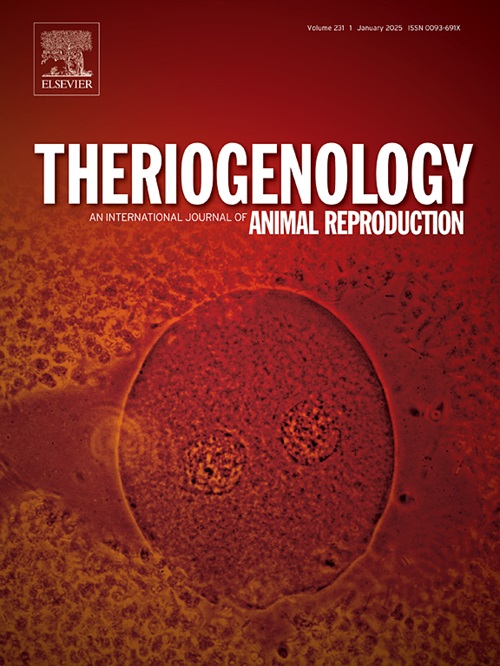Expression of TLR7/8 in canine sperm and evaluation of the effect of ligand R848 on the sorting of canine X/Y sperm
IF 2.4
2区 农林科学
Q3 REPRODUCTIVE BIOLOGY
引用次数: 0
Abstract
The aim of this study was to analyze the expression pattern of Toll receptor 7/8 (TLR7/8) in canine sperm, and explore the feasibility of using TLR7/8 ligand resiquimod(R848)to separate canine X and Y sperm. In this study, cellular immunofluorescence was used to analyze the expression of TLR7/8 in canine sperm, real-time fluorescence quantitative PCR was used to calculate the proportion of X sperm in the lower layer of the incubation solution with R848 to evaluate the sorting effect of R848 on canine X/Y sperm, and sperm quality detection system was used to analyze the effect of R848 on the motility of canine sperm. The mechanism of effect of R848 on canine sperm motility was analyzed by Western blot. The results showed that TLR8 was not expressed in all canine sperm, while TLR7 was expressed in all canine sperm and was localized in the head and tail of sperm. When 0.4 μM R848 was incubated with canine sperm for 1 h, the total motility, average path velocity (VAP), average straight-line velocity (VSL), and average curved-line velocity (VCL) of canine sperm were significantly decreased(P < 0.05). There was no significant difference between the lower and upper layers of the R848 treatment group and the control group(P > 0.05), and the proportion of X sperm was nearly half. The levels of NF-κB and GSK3α/β phosphorylation of sperm in R848 treatment group were significantly increased compared with control group(P < 0.05). The above results showed that TLR7/8 was not differentially expressed in canine X and Y sperm. R848 could decrease the motility of canine spermatozoa and inhibit sperm motility by the GSK3α/β-hexokinase pathway through the phosphorylation of NFκB and GSK3α/β, while could not separate X and Y spermatozoa. The method of sorting X/Y sperm based on TLR7/8 is not feasible for dogs.
TLR7/8在犬精子中的表达以及配体R848对犬X/Y精子分拣效果的评估。
本研究旨在分析Toll受体7/8(TLR7/8)在犬精子中的表达模式,并探讨使用TLR7/8配体瑞舒吉莫德(R848)分离犬X精子和Y精子的可行性。本研究采用细胞免疫荧光技术分析TLR7/8在犬精子中的表达,采用实时荧光定量PCR技术计算R848培养液下层中X精子的比例,以评价R848对犬X/Y精子的分选效果,并采用精子质量检测系统分析R848对犬精子活力的影响。通过 Western 印迹分析了 R848 对犬精子活力的影响机制。结果表明,TLR8 并未在所有犬精子中表达,而 TLR7 则在所有犬精子中表达,并且定位于精子的头部和尾部。当 0.4 μM R848 与犬精子孵育 1 小时后,犬精子的总运动能力、平均路径速度(VAP)、平均直线速度(VSL)和平均曲线速度(VCL)显著下降(P 0.05),X 精子的比例接近一半。与对照组相比,R848 治疗组精子的 NF-κB 和 GSK3α/β 磷酸化水平明显升高(P<0.05)。
本文章由计算机程序翻译,如有差异,请以英文原文为准。
求助全文
约1分钟内获得全文
求助全文
来源期刊

Theriogenology
农林科学-生殖生物学
CiteScore
5.50
自引率
14.30%
发文量
387
审稿时长
72 days
期刊介绍:
Theriogenology provides an international forum for researchers, clinicians, and industry professionals in animal reproductive biology. This acclaimed journal publishes articles on a wide range of topics in reproductive and developmental biology, of domestic mammal, avian, and aquatic species as well as wild species which are the object of veterinary care in research or conservation programs.
 求助内容:
求助内容: 应助结果提醒方式:
应助结果提醒方式:


